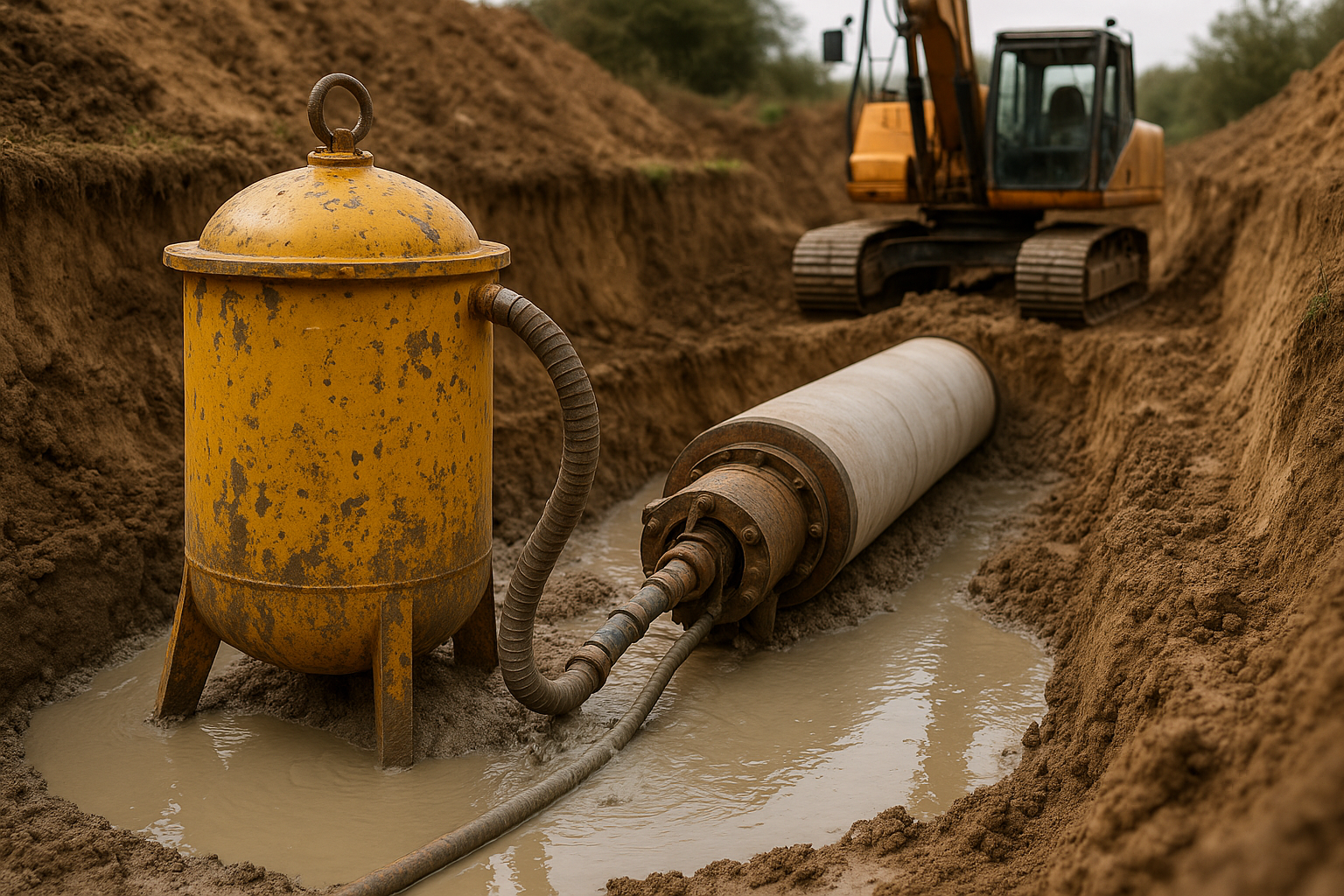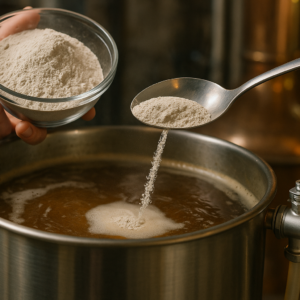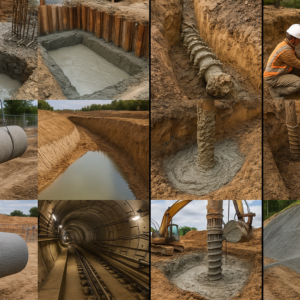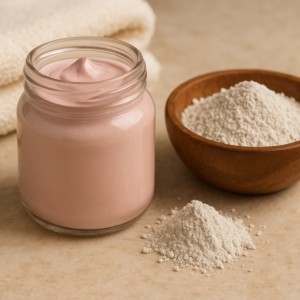Pipe jacking has changed how we install underground pipes. This trenchless method pushes prefabricated pipes through soil without digging trenches, and bentonite plays a central role in making it work. If you’re planning a pipe jacking project, understanding how to use bentonite properly can mean the difference between smooth progress and costly delays.
What Is Bentonite and Why Does It Matter in Pipe Jacking?
Bentonite is a natural clay mineral made mostly of montmorillonite. When mixed with water, it swells up to 15 times its original size and creates a thick, gel-like substance. This property makes it perfect for pipe jacking work.
Here’s what bentonite does during pipe jacking:
The slurry creates a protective layer, called a filter cake, around the gap between the pipe and the borehole wall. This layer keeps soil from collapsing onto the pipe while maintaining pressure that prevents settlement. The bentonite also cuts friction between the pipe surface and surrounding ground by up to 90%, which directly reduces the force needed to push pipes forward.
A properly mixed bentonite solution reduces jacking forces by forming a filter cake in the annular space while maintaining hydrostatic pressure to prevent soil settlement. This isn’t just about making the pipe “slippery.” The bentonite stabilizes the ground around your pipes and provides the lubrication you need for longer drives.
Choosing the Right Type of Bentonite for Your Project
Not all bentonite works the same way. The two main types are sodium bentonite and calcium bentonite, and they have different properties.
Sodium Bentonite
Sodium bentonite contains Na-montmorillonite and has much greater swelling capacity than calcium bentonite. When you add water, sodium bentonite can expand dramatically and create excellent sealing properties. This type works best for most pipe jacking projects because of its superior performance.
CMS Industries manufactures high-quality sodium bentonite that meets industry standards for trenchless construction. The company’s production facilities in Gujarat produce multiple grades suitable for different soil conditions you might face during pipe jacking.
Calcium Bentonite
Calcium bentonite swells less than sodium bentonite but still offers good adsorption properties. Some calcium bentonite can be converted to sodium bentonite through a process called sodium activation by adding sodium salts like sodium carbonate. This activated version performs closer to natural sodium bentonite.
For pipe jacking lubrication, sodium bentonite remains the preferred choice. Look for bentonite with high montmorillonite content, which gives you the best water absorption and swelling characteristics you need.
How to Mix Bentonite for Pipe Jacking: Step-by-Step Process
Mixing bentonite correctly determines whether your lubrication system works as intended. Poor mixing leads to lumps, incomplete hydration, and increased jacking forces.
Before You Start Mixing
Check your water quality first. The pH should fall between 8.5 and 9.5 for proper bentonite hydration. If your water is too acidic or too alkaline, add soda ash to bring it into the right range. Hard water with too many minerals also needs treatment with soda ash.
The Mixing Procedure
Follow these steps for proper bentonite mixing:
- Add Water First Fill your mixing tank with clean water before adding any bentonite. Never add bentonite to an empty tank.
- Start Mixing Equipment Turn on your high-shear mixer before introducing bentonite. The water should already be circulating.
- Add Bentonite Gradually Pour bentonite slowly into the mixing tank at no more than 50 pounds per 3-to-5 minute period. Adding it too fast causes granules to settle at the bottom without hydrating properly.
- Allow Proper Hydration Time Standard bentonite mixing units need 30 to 45 minutes for complete hydration, though high-shear mixers can cut this time by up to 50%. Don’t rush this step. Incomplete hydration means poor performance in the field.
- Check Consistency Your finished slurry should have a smooth, gel-like consistency without lumps. The typical concentration for pipe jacking lubrication ranges from 5% to 8% bentonite by weight, but this varies based on soil conditions.
Common Mixing Mistakes to Avoid
Watch out for these problems:
- Adding bentonite too quickly, which creates clumps that never hydrate
- Not mixing long enough before pumping
- Using water with wrong pH levels
- Skipping equipment cleaning between batches
CMS Industries provides technical guidance on proper mixing ratios for their bentonite products. The right ratio depends on your specific ground conditions and the trenchless equipment you’re using.
Ground Conditions and Bentonite Mix Design
Ground conditions affect how your bentonite mixture performs, and contractors see better productivity when they adjust lubrication mixes based on actual conditions encountered during advancement. A “one-size-fits-all” approach doesn’t work in pipe jacking.
Sandy and Gravelly Soils
In non-cohesive soils like sand and gravel, you need thicker bentonite suspensions. The slurry must support the borehole walls while creating an effective filter cake. Consider concentrations between 6% and 8% bentonite.
The filter cake forms quickly in sandy conditions and helps maintain annular space stability. Make sure your bentonite has high gel strength to prevent excessive fluid loss into porous formations.
Clay and Silt
Clay soils need different treatment. The ground provides some natural cohesion, so you can often work with slightly thinner bentonite suspensions (4% to 6%). In soils with small pore sizes like silt, the supporting effect comes from a relatively thin outer filter cake.
Watch for reactive clays that may interact with your bentonite slurry. Sometimes polymer additives help in these conditions, though many projects use bentonite alone successfully.
Mixed Ground Conditions
Real projects rarely feature uniform soil. When you encounter changing geology, adjust your mix accordingly. Start with a middle-range concentration and monitor jacking forces. If forces increase unexpectedly, your bentonite mixture might need modification.
Keep detailed records of which mixtures work best in different soil layers. This information helps you prepare for similar conditions in future projects.
Injection Strategy: Getting Bentonite Where It Needs to Go
Mixing good bentonite means nothing if you can’t inject it properly into the annular gap. Modern pipe jacking uses automatic lubrication systems that maintain consistent injection.
Injection Points and Spacing
Pipes come with pre-installed injection ports. These valved openings allow you to pump bentonite into the annular space at specific intervals. Typical spacing runs between 1.5 and 3 meters along the pipe string, depending on pipe diameter and soil conditions.
The first injection point should sit close to the tunneling machine. This ensures immediate lubrication as the pipe enters the ground.
Injection Pressure and Volume
Research shows that applying continuous bentonite injection, even under very low pressure, creates an interface that reduces the friction coefficient to approximately 10% of sand-concrete pipe friction. You don’t need massive pressure to get results.
Volume matters more than pressure in many cases. Industry guidelines suggest that one ton of dry bentonite produces approximately 12.8 cubic meters of slurry for pipe jacking applications. Calculate your annular gap volume and plan bentonite quantities accordingly.
Automatic systems monitor jacking forces and adjust injection volumes in real time. This keeps lubrication consistent throughout the drive.
Volume-Based vs. Interval-Based Injection
Two main strategies exist:
Volume-Based: The system injects specific volumes of bentonite based on distance advanced. For example, inject 200 liters per meter of advancement.
Interval-Based: Injection occurs at set time intervals, like every 5 minutes during jacking operations.
Most modern projects combine both approaches. The system uses volume-based injection as the primary method but adds interval-based top-ups during stoppages to maintain annular pressure.
Read More – What Is Iron Ore Pelletization Bentonite
Monitoring and Adjusting During Operations
Pipe jacking is not a “set it and forget it” process. Constant monitoring lets you catch problems early and adjust your bentonite program.
Key Parameters to Track
Watch these measurements:
- Jacking Forces: The main indicator of lubrication effectiveness. Rising forces often mean inadequate bentonite coverage or ground conditions different from expected.
- Bentonite Consumption: Track how much slurry you’re using compared to predictions. Excessive consumption might indicate fluid loss into porous ground or annular gap problems.
- Advance Rate: Slower than expected progress can signal lubrication issues or soil problems.
- Return Flow: Some bentonite should return to the entry shaft. No returns might mean blockages or excessive fluid loss.
When to Adjust Your Mix
Change your bentonite mixture when:
- Jacking forces climb steadily above predicted levels
- You’re using significantly more or less slurry than calculated
- Soil conditions change from what geotechnical reports indicated
- Stoppages create sudden force spikes when restarting
Small adjustments work better than dramatic changes. Increase or decrease bentonite concentration by 0.5% to 1% at a time and observe results over several meters of advancement.
Dealing with Stoppages
The friction increase after a stoppage depends not only on stoppage duration but also on the normalized lubrication volume used. Long stoppages let bentonite settle and allow ground to squeeze onto pipes.
When you stop jacking for more than a few hours, consider these steps:
- Maintain annular pressure with periodic bentonite injections
- Inject extra volume before restarting to refresh the filter cake
- Expect higher initial forces when resuming and have contingency plans ready
Equipment Needs for Bentonite Lubrication
Successful bentonite use requires the right equipment. Most pipe jacking contractors either own this gear or rent it for major projects.
Mixing Equipment
High-shear mixers give the best results. These units break down bentonite particles rapidly and cut hydration time in half compared to standard paddle mixers. The mixer should handle your volume needs without constant batching.
Storage tanks hold mixed bentonite until needed. Calculate tank size based on several hours of operation to avoid running short during critical phases.
Pumping Systems
Positive displacement pumps work best for bentonite slurries. These include progressive cavity pumps and Bowie-style pumps. They handle the thick, viscous material better than centrifugal pumps and maintain consistent delivery pressure.
The pump should connect to your pipe string through injection lines and valves. Automatic systems control pumping based on advance distance or time intervals you program.
Measuring and Monitoring Tools
You need ways to measure:
- pH meters or test strips for water quality
- Marsh funnel for measuring slurry viscosity
- Flow meters to track injection volumes
- Pressure gauges at injection points
- Jacking force monitoring on your pipe string
This instrumentation helps you make informed decisions during operations rather than guessing about lubrication effectiveness.
Calculating Bentonite Requirements for Your Project
Running out of bentonite mid-drive creates serious problems. Calculate needs carefully before starting.
Basic Formula
The annular gap volume determines base requirements:
Annular Gap Volume = (Borehole Diameter² – Pipe Outer Diameter²) × 0.7854 × Drive Length
This gives you cubic meters. Account for:
- Over-excavation by the tunneling machine (typically 10-30mm larger than theoretical)
- Losses into porous ground formations
- Extra volume for maintaining pressure during stoppages
- Safety margin of 20-30% for contingencies
Typical Consumption Rates
Different soils consume bentonite at different rates. General guidelines suggest:
- Dense soils: 50-100 liters per meter of pipe
- Medium dense soils: 100-200 liters per meter
- Loose, porous soils: 200-400 liters per meter
These are starting points. Your actual consumption depends on many variables including pipe diameter, overcut size, and specific ground conditions.
CMS Industries offers technical support to help calculate bentonite requirements for your specific project parameters. Getting quantities right prevents both shortages and excessive waste.
Safety and Environmental Considerations
Bentonite is generally safe to work with, but follow proper procedures to protect workers and the environment.
Worker Safety
Bentonite dust can irritate eyes and respiratory systems. Workers handling dry bentonite should wear:
- Dust masks or respirators in enclosed mixing areas
- Safety glasses or goggles
- Gloves when handling material
The mixed slurry is slippery. Keep work areas clean and provide non-slip surfaces where people walk.
Environmental Aspects
Bentonite is natural clay and generally environmentally friendly. It’s non-toxic and biodegradable. The material doesn’t harm groundwater if it escapes the borehole, though excessive returns to the surface need proper management.
Collect return flows and either recycle the bentonite or dispose of it according to local regulations. Many jurisdictions allow bentonite-laden water to settle in ponds where the clay separates naturally. The clarified water can discharge or reuse while the settled bentonite can return to the mixing cycle.
If your project runs near environmentally sensitive areas, document your bentonite use and returns. This protects against unfounded environmental concerns.
Troubleshooting Common Bentonite Problems
Even experienced contractors face challenges. Here’s how to handle common issues.
Excessive Jacking Forces Despite Bentonite Use
This frustrating problem has several possible causes:
- Insufficient Injection Volume: Increase the volume per meter of advance. The annular gap might be larger than calculated due to over-excavation or soil relaxation.
- Poor Bentonite Quality: Not all bentonite performs equally. If you’re using calcium bentonite or low-grade material, switch to high-quality sodium bentonite like those from CMS Industries.
- Injection System Problems: Check for clogged ports, broken valves, or pump malfunctions. One blocked injection point creates a gap in lubrication coverage.
- Unexpected Ground Conditions: Highly permeable soils can absorb bentonite faster than you can inject it. You might need thicker mixes or polymer additives.
Bentonite Not Returning to Entry Shaft
Some return flow is normal and healthy. Zero returns might indicate:
- Annular gap is too tight (pipe fits borehole too closely)
- High ground permeability absorbing all injected bentonite
- Blockage in the annular space from collapsed soil
- Insufficient injection volumes
Try increasing injection volumes first. If returns still don’t appear, investigate whether the tunneling machine is creating adequate annular clearance.
Excessive Bentonite Returns
Too much return flow wastes material and creates handling problems. Possible causes include:
- Over-excavation creating a larger annular gap than intended
- Injection volumes set too high for actual conditions
- Low ground permeability preventing bentonite absorption into filter cake
Reduce injection rates gradually and monitor jacking forces to ensure lubrication remains effective.
Bentonite Losing Viscosity
Bentonite suspensions can break down over time, especially if contaminated. Fresh mixing solves most viscosity problems. If you’re recycling returned bentonite, test its properties before reuse. Contamination from soil particles, groundwater chemistry, or other materials can degrade performance.
Long-Distance Drives and Special Considerations
Pipe jacking drives exceeding 100 meters need extra planning around bentonite lubrication.
Intermediate Jacking Stations
For longer drives, professionals recommend positioning ready-to-use intermediate jacking stations approximately every 80-120 meters, with the first unit as close as possible to the tunneling machine. These stations help overcome friction if lubrication proves less effective than planned.
Even with excellent bentonite lubrication, intermediate stations provide insurance. They let you complete drives even if unexpected ground conditions increase friction beyond initial calculations.
Maintaining Buoyancy
Full or near-full buoyancy of the pipeline has been demonstrated for the majority of properly lubricated drives. The bentonite slurry essentially floats the pipe in the annular space, dramatically reducing skin friction.
Monitor for signs of pipe settling, which indicate loss of buoyancy. This can happen if bentonite drains away into porous formations or if stoppages allow settling. Increased injection volumes restore buoyancy in most cases.
Curve Navigation
Pipes following curved alignments face higher friction. The pipe string presses against the borehole wall on curves, increasing resistance. Bentonite helps but can’t eliminate geometry-related friction.
For curved drives, increase bentonite injection volumes by 25-50% in curve sections. Pay close attention to jacking forces as the lead pipe enters and navigates curves.
Cost Optimization Without Sacrificing Performance
Bentonite represents a small portion of total pipe jacking costs, but wise use saves money.
Right-Sizing Your Bentonite Program
Over-engineering wastes money. Under-engineering risks project failure. Find the balance by:
- Using geotechnical investigation data to predict actual ground conditions
- Starting with industry-standard concentrations and adjusting based on observed performance
- Tracking consumption carefully and modifying injection volumes to match actual needs
- Recycling return flows when practical
Bulk Purchasing from Reliable Suppliers
Companies like CMS Industries offer competitive pricing on bulk bentonite orders. Buying enough for your entire project eliminates rush orders and takes advantage of volume discounts. CMS Industries’ strategic location near major ports allows efficient delivery to project sites throughout the region.
Make sure your supplier can provide consistent quality across all shipments. Switching bentonite types mid-project can create performance variations.
Balance Speed and Care
Rushing through mixing to save time creates problems that cost far more than the minutes saved. Similarly, advancing too quickly without maintaining proper lubrication leads to stuck pipes and expensive recovery operations.
Follow proper procedures, monitor continuously, and adjust proactively. This approach maximizes productivity while minimizing costly disruptions.
Frequently Asked Questions
What is the ideal bentonite concentration for pipe jacking lubrication? Most pipe jacking projects work with bentonite concentrations between 5% and 8% by weight. The exact concentration depends on your soil conditions. Sandy and gravelly soils typically need 6-8% concentrations to create strong filter cakes and maintain borehole stability. Clay soils often work well with 4-6% concentrations. Start in the middle of the appropriate range and adjust based on monitored jacking forces and bentonite consumption rates during your actual drive.
How long does bentonite need to hydrate before use in pipe jacking? Bentonite requires 30 to 45 minutes of mixing time to reach complete hydration in typical mixing units. High-shear mixers can reduce this time by about half. Never skip adequate hydration time even when you’re behind schedule. Incompletely hydrated bentonite won’t develop proper viscosity or gel strength, leading to poor lubrication performance. You’ll know bentonite is fully hydrated when it forms a smooth, uniform gel without lumps or dry particles visible in the mixture.
Can I reuse bentonite slurry that returns from the pipe jacking operation? Yes, you can recycle returned bentonite in many cases. The returned material should be screened to remove soil cuttings and debris, then tested for viscosity and gel strength. If properties remain within acceptable ranges, remix the recycled bentonite with fresh batches. Be aware that contamination from groundwater minerals or soil particles can degrade bentonite performance over time. If recycled bentonite shows reduced viscosity or unusual behavior, prepare fresh batches instead. Don’t compromise lubrication quality to save small amounts of material.
What should I do if jacking forces suddenly increase despite bentonite injection? First, verify your injection system is working properly. Check for clogged injection ports, valve failures, or pump problems. If equipment is functioning correctly, increase bentonite injection volume by 25-50% and monitor force response. The ground conditions might differ from expectations, requiring more lubrication. If forces remain high after increasing injection, consider whether the annular gap has closed due to ground movement or if you’ve encountered unexpected soil conditions. Stop advancing and investigate before continuing to prevent pipe damage.
What’s the difference between sodium bentonite and calcium bentonite for pipe jacking? Sodium bentonite has considerably greater swelling capacity than calcium bentonite, making it the preferred choice for pipe jacking lubrication. Sodium bentonite can expand up to 15 times its original volume when hydrated, creating excellent sealing and lubricating properties. Calcium bentonite swells less but costs less too. Some calcium bentonites can be activated with sodium compounds to improve their performance. For best results in pipe jacking, specify high-quality sodium bentonite with high montmorillonite content from established suppliers like CMS Industries.







